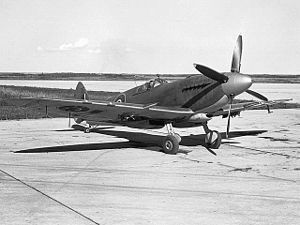Supermarine Seafire
| Seafire | |
|---|---|
 |
|
| A Seafire XV in Royal Canadian Navy service | |
| Role | Carrier-based fighter |
| Manufacturer | Supermarine |
| First flight | 7 January 1942 |
| Primary users |
Royal Navy French Navy Irish Air Corps Royal Canadian Navy |
| Number built | 2,334 |
| Developed from | Supermarine Spitfire |
The Supermarine Seafire was a naval version of the Supermarine Spitfire adapted for operation from aircraft carriers. The name Seafire was arrived at by abbreviating the longer name Sea Spitfire.
The Admiralty first showed an interest in the idea of a carrier-borne Spitfire in May 1938 when, during a meeting with Richard Fairey (of Fairey Aviation), Fairey proposed that his company could design and build such an aircraft. The idea met with a negative response and the matter was dropped. As a result, the Fleet Air Arm (FAA), at that point still part of the Royal Air Force, was forced into having to order Blackburn Rocs and Gloster Sea Gladiators, both of which proved to be woefully inadequate. Upon the outbreak of the Second World War, many of the aircraft operated by the FAA were considered to be obsolete in comparison to Germany's land-based fighters; thus the need for more capable aircraft was readily apparent. As the Hawker Hurricane had quickly proven to be adaptable to carrier-based operations, there was considerable interest in navalising the Spitfire as well.
The matter of a seaborne Spitfire was raised again in November 1939 when the Air Ministry allowed a Commander Ermen to fly a Spitfire I. After his first flight in R6718 Ermen learned that Joseph Smith, Chief Designer at Supermarine had been instructed to fit an "A-frame" arrestor hook on a Spitfire and that this had flown on 16 October; a drawing of this aircraft had been shown to the FAA on 27 October. After further discussions Supermarine submitted a drawing of a Spitfire with folding wings and an arrestor hook. In this case the wings were designed with a fold just outboard of the undercarriage bays; the outer wings would swivel and fold backwards, parallel with the fuselage. On 29 February 1940 the Admiralty asked the Air Ministry to sanction the production of 50 folding-wing Spitfires, with the first deliveries to start in July. For various reasons Winston Churchill, who was First Lord of the Admiralty cancelled the order, writing to Lord Beaverbrook: "I regard it as of very great importance that the production of Fulmars should be kept going".
...
Wikipedia
